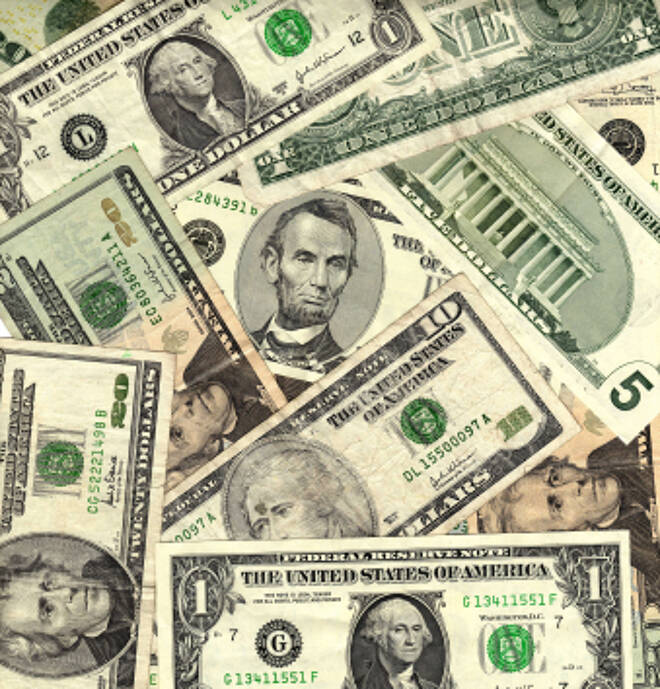Advertisement
Advertisement
Dovish Central Bank Outlooks Make U.S. Dollar More Desirable Asset
By:
A series of events throughout the week helped drive the dollar even higher, but for different reasons. This time, it wasn’t higher yields driving the greenback higher, but rather safe-haven buying related to growing concerns over the weakening global economy and renewed concerns over U.S.-China relations which drove down appetite for higher risk assets.
The U.S. Dollar soared against a basket of currencies last week taking the index to its highest level since January 2. The index is also trading higher for the year, recovering from a bearish outlook generated by recent dovish U.S. Federal Reserve policy remarks. The Fed is still dovish, but so are all the major central banks. This neutralized the Fed remarks and turned the dollar into a more desirable investment. Safe-haven buying due to the shedding of higher risk assets also underpinned the greenback.
For the week, March U.S. Dollar Index futures settled at 96.416, up 1.116 or +1.17%.
Dollar Supported Early by Bullish U.S. Economic Data
Buyers came in early last week to support the U.S. Dollar. The catalyst behind the move was the previous Friday’s robust U.S. Non-Farm Payrolls report and stronger-than-expected ISM PMI manufacturing report. This news drove up U.S. Treasury yields because it raised concerns that perhaps the Fed had it wrong, and that the U.S. economy was actually strong enough to withstand at least one interest rate hike in 2019.
New Support for Dollar Driven by Series of Events
A series of events throughout the week helped drive the dollar even higher, but for different reasons. This time, it wasn’t higher yields driving the greenback higher, but rather safe-haven buying related to growing concerns over the weakening global economy and renewed concerns over U.S.-China relations which drove down appetite for higher risk assets.
The key events driving the dollar higher were a bearish outlook for the Euro Zone economy, uncertainty over U.S.-China trade relations and the possibility of a rate cut by the Reserve Bank of Australia.
European Commission Lowers Outlook for Euro Zone Economy
The European Commission sharply cut its forecasts for Euro Zone economic growth this year and next on expectations the bloc’s largest countries will be held back by global grade tensions and domestic challenges. The Commission said Euro Zone growth will slow to 1.3 percent this year from 1.9 percent in 2018, before rebounding in 2020 to 1.6 percent.
This news drove the Euro sharply lower, driving up the U.S. Dollar Index. The Euro has the greatest influence over the index because it carries a weight of about 58 percent.
Negative News About U.S.-China Trade Relations Drives Down Appetite for Risky Assets
Negative comments about U.S.-China trade relations drove U.S. stock indexes lower last week, driving investors into the safety of the U.S. Dollar.
The major stock indexes topped out and the selling began after White House economic advisor Larry Kudlow said that China and the U.S. were still far away on striking a trade deal. Later in the session, stocks weakened further after CNBC reported that the Trump-Xi meeting before the March 2 deadline was “highly unlikely.”
Reserve Bank of Australia Spikes U.S. Dollar Higher
The Reserve Bank of Australia (RBA) may have telegraphed a rate cut for later in the year when it made a substantial downward revision to its growth forecasts in its quarterly Statement of Monetary Policy (SoMP). This drove the Australian Dollar sharply lower, making the U.S. Dollar a more attractive investment, as it led to a widening of the spread between U.S. Government bonds and Australian Government bonds.
Dollar’s Outlook is Mixed
The U.S. Dollar Index is likely to continue to be supported by safe-haven buying driven by lower demand for risky assets. This move is likely to continue if stocks continue to weaken. Furthermore, any signs of a strengthening U.S. economy will be supportive for the greenback.
The U.S. Dollar Index could weaken if oversold conditions provide support for the major currencies in the index especially the Euro. Additionally, renewed optimism over U.S.-China trade relations could encourage traders to lift their dollar hedges, putting further pressure on the greenback.
About the Author
James Hyerczykauthor
James Hyerczyk is a U.S. based seasoned technical analyst and educator with over 40 years of experience in market analysis and trading, specializing in chart patterns and price movement. He is the author of two books on technical analysis and has a background in both futures and stock markets.
Advertisement
